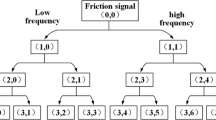Abstract
The Young’s modulus of abrasive and the material to be cut will have different influences on the cutting performance of the abrasive suspension jet (ASJ). It is found that the relative ratio of their Young’s modulus seems to show a better law on cutting performance of ASJ. In this paper, the concept of relative Young’s modulus was proposed, the influence of relative Young’s modulus on cutting performance of ASJ was explored, and the experiment of the influence of relative Young’s modulus on the kerf depth and surface roughness of ASJ was carried out. The results showed that the kerf depth increases with the increase of relative Young’s modulus. When the value is larger than 1, the density of the abrasive is the main factor affecting the kerf depth. When the value is smaller than 1, the Young’s modulus of the abrasive is the main factor affecting the kerf depth. The surface quality is divided into three degrees according to roughness. When the relative Young’s modulus is smaller than 1.5, it is a poor erosion degree. When the relative Young’s modulus is between 1.5 and 4, it is the best quality degree. When the relative Young’s modulus is larger than 4, it is an over erosion degree.














Similar content being viewed by others
Data availability
The data sets supporting the results of this article are included within the article and its additional files.
References
Hashish M (1991) Characteristics of surface machined with abrasive water jet. J Eng Mater Technol ASME 113:354–362
Hashish M (1988) Visualization of surfaces machined with abrasive water jet cutting process. Exp Mech 28:159–168
Yang Z, Chen SM, Zhang YJ, Li M (2009) Development and application of high pressure water jet technology. Mech Manag Dev 24:87–90 (in Chinese with English abstract)
Feng YX (2007) Abrasive water jet milling ceramic materials processing technology research. Dissertation, Shandong Univ (in Chinese with English abstract)
Wang YW (2013) Abrasive water jet cutting titanium alloy experimental study. Dissertation, Xihua Univ (in Chinese with English abstract)
Rongrun R (2002) Current status and development trend of water jet processing technology. Aviat Precis Manuf Technol 38:12–14
Momber AW, Kovacevic R (1998) Principles of abrasive water jet machining. Springer, London. https://doi.org/10.1007/978-1-4471-1572-4
Wang FC, Zhou DP, Xu QW, Qiang CH, Guo CW (2018) Mathematical model of rock stress under abrasive slurry jet impact based on contact mechanics. Int J Rock Mech Min 107:1–8
Srivastav AK, Dwivedi SP, Maurya NK, Sahu R (2020) Surface roughness report and 3D surface analysis of hybrid metal matrix composites (MMC) during abrasive water jet (AWJ) cutting. Rev Compos Mater Av 30(3–4)
Chen X, Guan J, Deng S, Qiang L, Ming C (2018) Features and mechanism of abrasive water jet cutting of Q345 steel. Heat Technol 36(1):81–87
Yang G, Feng B (2020) Orthogonal experiment on the surface quality of carbon Fiber reinforced plastic cut by abrasive water jet. Rev Compos Mater Av 30(2):69–76
Bruno Arab P, Barreto Celestino T (2020) A microscopic study on kerfs in rocks subjected to abrasive waterjet cutting. Wear 448–449:203–210
Krenicky T, Servatka M, Gaspar S, Mascenik J (2020) Abrasive water jet cutting of hardox steels-quality investigation. Processes 8(12):1652. https://doi.org/10.3390/pr8121652
Niranjan CA, Srinivas S, Ramachandra M (2018) An experimental study on depth of cut of AZ91 magnesium alloy in abrasive water jet cutting. Mater Today: Proc 5(1):2884–2890
De Abreu E, Lima Ipar CE, Neis PD, Ferreira NF, Lasch G, Zibetti TF (2020) Analysis of the initial damage region in agate plates cut by abrasive waterjet (AWJ) process. Int J Adv Manuf Technol 109(9–12):2629–2638
Armağan M, Arici AA (2017) Cutting performance of glass-vinyl ester composite by abrasive water jet. Mater Manuf Processes 32(15):1715–1722
Kechagias J, Petropoulos G (2012) Application of Taguchi design for quality characterization of abrasive water jet machining of TRIP sheet steels. Int J Adv Manuf Technol 62(5–8):635–643
Armağan M (2021) Cutting of St37 steel plates in stacked form with abrasive water jet. Mater Manuf Process 36(11):1305–1313
Santhanakumar M, Adalarasan R, Rajmohan M (2015) Experimental modelling and analysis in abrasive waterjet cutting of ceramic tiles using grey-based response surface methodology. Arab J Sci Eng 40(11):3299–3311
Qiang CH, Wang FC, Guo CW (2019) Study on impact stress of abrasive slurry jet in cutting stainless steel. Int J Adv Manuf Technol 100(1–4):297–309
Funding
This study was funded by the National Natural Science Foundation of China (Grant No: 52104150), the Natural Science Foundation of Jiangsu Province (Grant No: BK20200657) and Hebei Natural Science Foundation Ecological Wisdom Mine Joint Fund Project (Grant No: E2020402075).
Author information
Authors and Affiliations
Contributions
Chiheng Qiang conceived of the study, designed the study, and wrote the manuscript. All authors were involved in collecting and analyzing the data, also revisions.
Corresponding author
Ethics declarations
Ethics approval
Not applicable.
Consent to participate
Not applicable.
Consent for publication
All authors agree to transfer copyright of this article to the Publisher.
Competing interests
The authors declare no competing interests.
Additional information
Publisher's note
Springer Nature remains neutral with regard to jurisdictional claims in published maps and institutional affiliations.
Rights and permissions
About this article
Cite this article
Qiang, C., Yang, K., Warisawa, S. et al. Proposal of “relative Young’s modulus” and its influence on cutting performance of abrasive suspension jet. Int J Adv Manuf Technol 121, 4625–4641 (2022). https://doi.org/10.1007/s00170-022-09677-0
Received:
Accepted:
Published:
Issue Date:
DOI: https://doi.org/10.1007/s00170-022-09677-0



